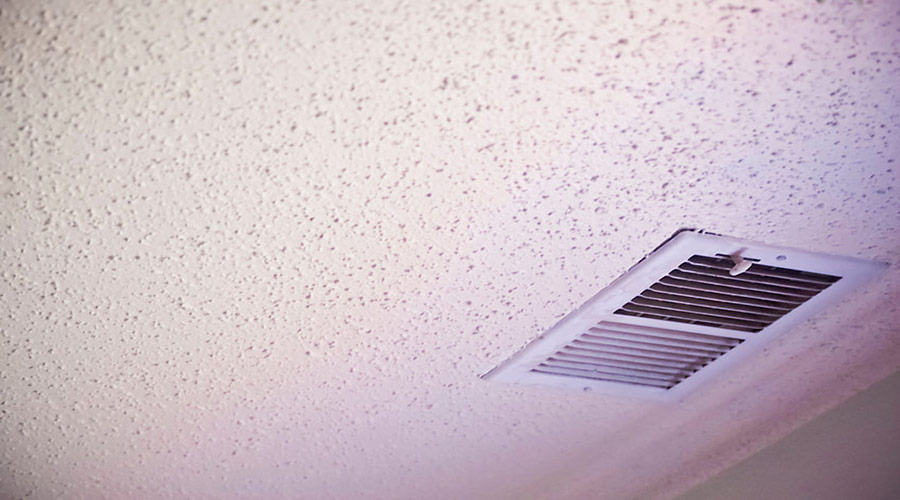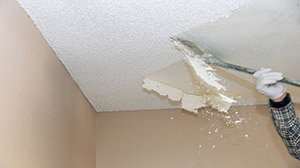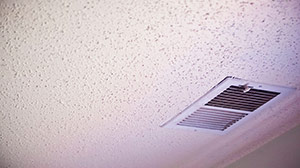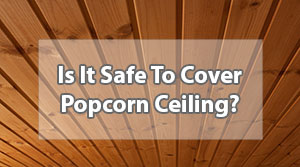
Do you live in a home built between 1930 to 1980? The ceiling is probably a popcorn ceiling. And if you follow modern building trends and standards, you already know popcorn ceilings have been getting a bad rep, and most people are phasing them out. You wonder what’s so wrong with them.
Popcorn ceilings are considered bad for these quick reasons:
- They’re an old construction cost-saving shortcut
- There’s a risk of asbestos and lead
- They dim the room
- They leave a mess when they peel off
Despite the bad rep that popcorn ceilings have, some people are comfortable with it. It hides flaws, gives off a unique look, and is even considered vintage. So why is it such a big deal in modern housing, and what is so bad about it?
Let’s examine what makes popcorn ceilings so unpopular.
The Rise Of Popcorn Ceiling
Popcorn ceilings were born out of necessity for a quick way to finish the interior of the house. Construction can be a money pit. Most contractors want to deliver a good housing project and not end up in a cash hole.
Ceilings were supposed to be flat, smooth, and well painted. However, a high-quality finish such as a smooth painted ceiling would have driven up the building costs. The alternative was to spray the ceiling and flatten it out.
Unsurprisingly, it worked. The popcorn ceiling was fast, it covered up imperfections, and you could even paint it. It had a bunch of other benefits too.
- It was lightweight
- It was durable
- It cost less than conventional methods.
- It didn’t peel off.
Not only did it hide flaws in the completed ceiling, but it also acted as an acoustic.
There was just one problem. One of the primary materials used in this ‘miracle ceiling’ was asbestos. Asbestos is a naturally occurring element with fibers that make it fire retardant, shock-proof, and an excellent insulator.
There was just one problem with asbestos.
Asbestos would peel off the ceiling if it were disturbed. The asbestos fell in tiny fibers, becoming a deadly health menace in many homes.
Asbestos is the leading cause of mesothelioma, a type of cancer. It wasn’t easy to pin asbestos to the rise of mesothelioma cases. However, when the cases piled, and it was no longer in doubt, asbestos had to go.
The government, through the Clean Air Act, outlawed asbestos as a building material in 1978. Until today, some people suffer from long-term exposure to asbestos, primarily from their ceilings.
Why are there popcorn ceilings today if asbestos was banned from being a component?
When the government banned asbestos, popcorn ceilings didn’t die out. They were replaced by a building material less harmful but did the same thing. Styrofoam became the new popcorn ceiling. It has two of asbestos’ better qualities that make it an attractive option.
Styrofoam is a good sound absorber and heat insulator.
If styrofoam is a safer option for ceilings, why are popcorn ceilings falling in popularity?
What Is So Wrong With Popcorn Ceilings?
You could install a styrofoam popcorn ceiling today, and it still won’t be popular. Most modern homeowners frown upon the idea of having a popcorn ceiling in any home built after the ’80s and ’90s. Popcorn ceiling fails at certain aspects that homeowners consider essential for comfort.
Bad Lighting
Light is one of the most important aspects of a home for buyers. It affects the interior mood and the house’s appearance and, at times, limits the buying options when a house is on the market. But popcorn ceilings make houses dimmer or darker.
The popcorn ceilings, even in styrofoam, are not flat. The spaces left create mini craters. Ceiling lights cast shadows on the ceiling, which reduces light dispersion across the whole room. In cases where the dimming effect is not too prominent, the lighting is not as bright as you would expect in a flat ceiling.
To compensate, you have to spend more on additional light fixtures. In the worse case, bad lighting due to popcorn ceilings increases your energy costs.
It’s Hard To Clean
When you think it, ceilings don’t get dirty. Maybe not as dirty as walls or floors. Still, popcorn ceilings gather dust that accumulates, making them hard to clean. A room such as a kitchen or a bedroom easily collects dust over time. A living room gathers dust, too, if it has heavy in and out traffic.
For instance, vapor settles on the ceiling if the weather’s humid. Any dust in the room that rises to the ceiling gets stuck to the moisture. Over time, this creates gunk.
The problem with gunk is that you can’t clean it up from time to time. You can brush it off or dust it off. Still, it won’t leave your ceiling as pristine as it was when it was freshly sprayed.
Over time, you won’t only be dealing with accumulated dirt. The light in the room will be bouncing off a dull surface, robbing you of much-needed light.
While we’re talking about dirt, let’s not forget about discoloration.
Discoloration on popcorn ceilings is common in rooms where there’s a water feature above the ceiling. Water stains show easily on ceilings. Water stains are, in most cases, inevitable.
Combine water stains and dust, and you have a reason to want to scrape the entire ceiling off.
It Lowers The Value Of The Home
While asbestos might have been phased out as a building hack, some houses still install popcorn ceilings. It’s a different time now, and impressions matter. Homeowners want updated styles, and most buyers don’t like popcorn ceilings because of their old-looking visual and handful removal.
The last thing you want to see as a homeowner is a house with hacks. Even with the best intentions, popcorn ceilings have the impression that they are hiding flaws in the house, and the builder didn’t commit to building a valuable home.
It piles pressure on anyone trying to sell the house. Unless they find someone who still appreciates the old style of doing things, a house with a popcorn ceiling might stay on the open market longer than is necessary.
It’s Not Visually Appealing
Visual appeal is a personal thing, especially when we talk about housing. Popcorn ceilings tend to look outdated, and it is not a sight to see in every house. There’s no blanket look that everyone must like for your house to be accepted.
The housing market is different. Buyers are different. The generations buying houses are asking for new ways of doing things. More recent ceiling designs are bolder, and they are allowing new owners to experiment with lighting.
Features such as false ceilings, gypsum ceilings, and glass ceilings are gaining traction among the growing class of incoming homeowners. The vintage popcorn ceiling aesthetic might hold up for people in touch with the nostalgia of an older time.
Popcorn Ceilings Shrink The Room
Interior design involves an aspect of illusion. Though it’s not a focal point of the room, you can see the roughness of the popcorn ceiling in the periphery of your eye. Because of the popcorn ceiling’s rough texture, it appears lower than it is. It gives the impression that the room is smaller.
The dimming effect caused by the mini craters makes the claustrophobic illusion worse.
It Makes Ceiling Repair Jobs More Challenging
For an affordable method of finishing the ceiling, popcorn ceilings can be challenging to repair when damaged in an area. Say you have water damage or a ceiling with unsightly stains.
You have to remove the affected area and match the replacement styrofoam. The result has to match the color of the entire ceiling. You also have to level the new area to be in line with the unaffected surface. If you have a water leak, you may not know the extent of the damage if it only shows in a small ceiling area.
Is It Dangerous To Live In A House With A Popcorn Ceiling?
While it has plenty of unpleasant sides, most of the disadvantages of popcorn ceilings are purely on aesthetics. There is no inherent danger in living in a house with popcorn ceilings unless the ceiling is chipping off.
Most popcorn ceilings built after the asbestos ban are not dangerous. However, you need to be mindful of dust due to allergens. Popcorn ceilings need a homeowner with a keen eye to make sure the ceiling is clear of things like webs.
It might be dangerous to your finances if you hurry to sell in a housing market that attracts buyers looking for modern inputs.
What Can You Do To Maintain A Popcorn Ceiling?
If the popcorn ceiling doesn’t pose any immediate danger, you can keep it. You can maintain it with a few solutions.
Clean Your Ceiling
Popcorn ceilings need a thorough cleaning every six months. Consider its maintenance. However, you can clean the ceiling as frequently as you like as long as you keep it intact. This step-by-step guide should keep your ceiling clean.
1. Wear protective eyewear, gloves, and masks to avoid any allergic or respiratory reactions.
2. Dust first the corners and clear any cobwebs using a light duster. The cleanest method would be to use a vacuum cleaner, preferably with a custom extension that reaches corners. Use a lint roller to gather anything stuck in the ceiling’s mini craters.
3. Clean the stained areas with bleach. Be careful with liquid cleaning the ceiling. Start with a small test area. Make sure the liquid doesn’t soak into the ceiling, or it will make it weak. Mix a cup of bleach with cups of water. Spray the stained area and dab with a sponge. Respray the bleach solution if the stain is still visible.
4. Greasy stains are more problematic. Mix a quarter gallon of water with a teaspoon of dish soap. Spray on the grease stain and dab with a sponge. Don’t rub.
5. Allow the cleaned area to dry, preferably overnight.
6. Paint over the clean and dry ceiling.
Get Eco-Efficient Lighting
You don’t have to remove the ceiling if the lighting is the problem. You can get eco-efficient lighting and accessories for your room. You can use light fixtures on the wall and around the room. Lamps and wall bulbs do a great job of lighting up the room. You can get different color bulbs to match any mood you intend on setting in the room. The kicker is, it can help not run up your energy bill.
Paint The Ceiling
Painting the ceiling with your preferred color is a great way to breathe modernity into an old building style. If you are sure the underlying ceiling has no gaps that could make it hard to identify stains and dirt, you can even use different colors and tones.
However, it is safer to paint it white, so you always know when it needs cleaning.
Pro tip: Go for a slightly off-white color to make the room look larger. Earth tone colors such as beige have a largening effect on interiors.
Divert Attention From It
Ceilings don’t attract much attention unless you intend on doing it. Wall decor such as tapestry and accessories like a clock diverts attention from the ceiling. Pair the wall decor with decorative lighting fixtures.
Alternatively, make sure the room is well decorated at eye level. Vases, lamps, and houseplants can elevate a room’s visual appeal and draw away attention from the ceiling.
Can I Cover A Popcorn Ceiling?
Popcorn ceiling is harmless if it doesn’t chip or disintegrate. So, you can cover the ceiling and give your house the upgraded look it needs. You have two effective ways to cover the popcorn ceiling.
- Paneling: Panelboards come pre-made and designed with different textures. Choose a panel that is similar in color to the ceiling. You don’t have to cover anything else as long as you make sure there are no gaps and holes underneath the ceiling.
- Gypsum boards: Gypsum boards and drywall are similar. You can get modern custom gypsum boards that include extra lighting features. The beauty of gypsum boards is they’re lightweight, and they’re not high maintenance.
Should You Remove Popcorn Ceiling?
Apart from being a remnant of old building styles, popcorn ceilings are manageable. You can leave them undisturbed, and they will serve you for a long time.
Ask yourself why you want to get rid of the popcorn ceilings. If the answer to the following questions is a yes, you should definitely remove your popcorn ceiling.
- Do you want to resell?
- Do you have the time?
- Can you pay for removing the popcorn ceiling and installing a modern ceiling?
Conclusion
Popcorn ceilings were once a mainstay in many homes. However, times have evolved, and construction has adapted new ways and better technologies. Ask yourself if you would like to adopt as well, or you’d rather play it safe and maintain your popcorn ceiling. If popcorn ceilings aren’t putting you in any medical danger, it’s entirely up to you to keep them or change.




